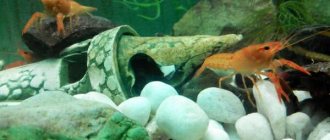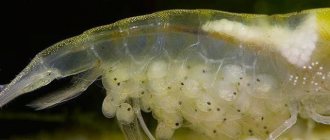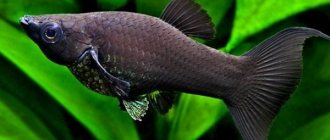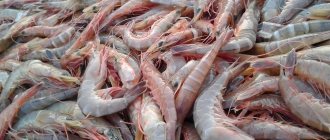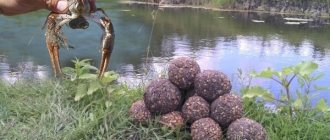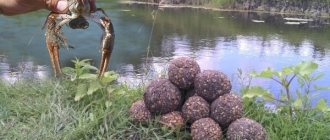06/14/2021 642 Fisherman's workshop
Author: Alexander
Breeding crayfish involves creating artificial habitat conditions for arthropods similar to their natural environment. You can grow arthropods both outdoors and indoors, provided you have the necessary equipment and follow the rules of care.
[Hide]
Advantages and disadvantages of business
As with any business, crayfish farming has both advantages and disadvantages.
Flaws:
- high costs for creating crustaceans as close as possible to natural habitats;
- seasonality of earnings, this is due to the timing of reproduction - from May to October;
- slow return on investment, since the growth of fry in the winter period sharply decreases;
- making a profit is possible only from the 2nd year of operation.
The disadvantages will decrease after some time due to lower costs of maintaining the habitat and faster growth of the fry.
Photo gallery of crayfish breeding:
Advantages:
- minimal competition in the market;
- rapid expansion of the customer base due to low competition;
- labor costs are low;
- business profitability is high.
The niche of crayfish breeding is practically unoccupied, and therefore a rapid rate of increase in volumes and obtaining fairly high incomes is possible.
Video
Breeding and growing crayfish as a business idea from the “Peasant Business Ideas” channel.
Was this article helpful?
Thank you for your opinion!
The article was useful. Please share the information with your friends.
Yes (100.00%)
No
X
Please write what is wrong and leave recommendations on the article
Cancel reply
Rate the benefit of the article: Rate the author ( 2 votes, average: 5.00 out of 5)
Discuss the article:
Crayfish breeds for breeding
There are several breeds of crayfish that are convenient for breeding. Among the most common are the following.
Australian
The Australian Red Claw Crayfish is the breed with the most meat. It requires special breeding conditions: a closed pond with mandatory additional heating. To keep 3-4 individuals, you need an aquarium with a volume of at least 100 liters.
An important condition is the organization of free space on the surface of the aquarium, since this type of crustacean likes to float to the surface and stay there for some time. Snags, holes and shelters are placed at the bottom. They are important because crayfish rest there, eat, and wait out the molting period.
It is unpretentious in food; it happily eats dead fish, bread, algae and ready-made food. Together with these crayfish you can keep fish, for example, guppies.
Blue Cuban
They are extremely unpretentious. They live in water with high hardness at a temperature of +26 °C. Adults are medium in size when compared to other species. They are not picky about food, they feed on everything they find at the bottom. But cases of attacks on nearby fish cannot be ruled out. By the age of six months they reach sexual maturity. Like all crayfish, they need driftwood and grottoes on a sandy bottom. You need to place a device for filtering and aerating water in the aquarium.
Marble
This type of crayfish, just like the Australian one, requires certain conditions of detention and care. Water should be within +20...+28 °C with mandatory aeration and filtration. A distinctive advantage is the ability to keep about 20 individuals in 100 liters of water. You need to feed a lot and often.
An advantageous feature of this species is that they are hermaphrodites and reproduce by parthenogenesis. The larvae are incubated on the abdomen for 30 days. After the fry appear, they must be removed from the adults into a separate aquarium, otherwise the parents will eat their offspring.
Incubation apparatus (IRIK)
The incubation apparatus is a box with a set of cells; an egg crayfish is placed in each cell. The cell initially contains females with embryos, and then with crayfish larvae, which are kept in the apparatus until the end of the first molting of the grown-up juveniles. The capacity of the IRIK is 50 female crayfish, the cell dimensions are 150 x 50 x 45 mm. At the bottom of the cell there should be a 1 cm wide gap where the crayfish larvae will emerge after the first molt.
One lid is intended for ten cells (20 holes with a diameter of 1 cm are made in the lid above each cell - this is done to improve water exchange). The covers are located under water. The shelf with the described cells is installed in a seven-story rack.
Read the continuation of the article on the next page. To move to the next part of the article, use the page navigation numbers.
Selection and purchase
When breeding crayfish, you should give preference to long-fingered breeds; they are less demanding in terms of living conditions and gain weight faster compared to wide-fingered varieties.
It is also worth carefully monitoring the temperature of the water in the reservoir where the crayfish are located. So, if the environment is too cool, their vital processes will slow down and weight gain will be minimal, and the fertility of females will also decrease. In good conditions, after a single fertilization, the female will bring 60-230 fry.
It is imperative to take into account the territorial characteristics of the climate in which it is planned to breed crayfish. For example, if the breeder lives in central Russia, then you need to buy crayfish in nearby regions. This is due to the fact that with a sharp change in climate and long transportation, crayfish may begin to have problems with adaptation and the population may die. One of the best options is to catch crayfish in a local pond and breed them. This way, the change in habitat will be practically unnoticeable for them.
The number of individuals is calculated taking into account the volume of the artificial reservoir: per 1 sq. m. area maximum quantity – 6 crayfish. It is important that there are at least 2 males for optimal production of offspring.
Most Valuable Representatives
The most famous representative is the broad-toed crayfish, widespread throughout Europe. And although the population of this species declined sharply at the turn of the 19th and 20th centuries. , in Russia it does not have the status of a vulnerable animal.
But three other representatives of the class of higher crayfish that are endangered are listed in the country’s Red Book, namely:
- The mantis crab, which got its name from its bent forelimbs. This animal has distinctive claws painted bright green. They have powerful striking power, so they can be successfully defended. The arthropod is a predator, and quite an aggressive one at that. Two males fight for a female, causing each other severe injuries. https://www.youtube.com/embed/i7sxBhemBso
- The Japanese crab is found in Peter the Great Bay. The animal is small in size, not exceeding 10 cm. Females are usually slightly wider than males.
- Deryugin crab, named after the Russian zoologist. It lives in the North Pacific Ocean. Externally it differs from other crabs in its asymmetrical abdomen and one reduced pair of walking legs. The animal has an unusual color - the shell is orange or greenish on top, the legs are brown, and the claws are bright red.
These animals are protected from hunting at the legislative level.
Sometimes doubts arise whether a cancer is a fish or an animal. The answer to this question is obvious: the group of arthropods has nothing to do with fish ; they are related only by their habitat. But representatives of both taxa belong to the animal kingdom.
Mr. Tail recommends: breeding methods
Due to minimal investment and increased demand, crayfish breeding farms are now becoming increasingly popular. They are grown in natural and artificial ponds, aquariums, swimming pools, in special installations and containers. There are several farm options.
In the pond
If there is a natural reservoir, this method is the least expensive, but if there is no natural one, they dig a pond on their own on a piece of land, for example, in a country house. It is important to take into account the estimated number of crayfish. A prerequisite is the presence of sand at the bottom and a system for purifying and aerating the water.
Crayfish are unpretentious in nutrition, but require a sufficient amount of food. They prefer small fish, their fry, carrion, and aquatic plants. Therefore, you need to breed them in a reservoir along with other underwater inhabitants.
The disadvantage of this method of growing crustaceans is that they hibernate in winter, and therefore their weight gain during this time will be minimal.
In the basement
This method is more expensive than the previous one. After all, you need to purchase the necessary equipment both for growing crayfish and for creating a certain microclimate in the basement or cellar itself. The walls of the room where breeding is intended must be treated with an antiseptic to prevent the development of mold. The air temperature in the basement should not be lower than +8 °C; it is necessary to install lamps for artificial lighting. There must be two aquariums or pools with forced aeration and water filtration: for young animals, for adults and growing individuals.
It is important to organize sufficient air ventilation in the basement; this will prevent the development of mold on the walls and reduce air humidity.
The advantages of this method are as follows: crayfish do not hibernate in the winter and, accordingly, gain weight faster, which leads to increased profits.
In aquarium
At home in aquariums, crayfish are bred only in heated rooms with the obligatory presence of electricity and constant access to water. If you plan to organize a farm in a private house or on a garden plot in a village, you can bury the aquarium directly into the ground (in summer) to a depth of 2/3 of the height of its wall.
There are a number of factors that are important to observe when breeding crayfish in an aquarium:
- volume not less than 250 l;
- water hardness in the range of 10-12;
- maximum height of the aquarium – 1 m;
- the bottom should be as wide as possible;
- water temperature +17…+21°C.
When choosing an aquarium, experts recommend choosing plastic ones - this is the most convenient option for breeding crayfish.
This is a more expensive method, but its advantage is that the crayfish will not hibernate.
In RAS (recirculated water supply installation)
Such a factory installation requires large financial costs compared to other methods of breeding crayfish, but has a number of advantages:
- occupies a small area;
- reduces water consumption;
- can be used all year round regardless of the seasons;
- you can control the life activity of crayfish and the operation of the industrial system;
- waste disposal is simplified as much as possible.
In a swimming pool
This breeding method is the most practical and popular. You can make a pool yourself from concrete or purchase a ready-made one from special plastic or polycarbonate. Its depth must be at least 90 cm, but not exceed 1 m. A system for water aeration must be installed. The tank must also be waterproofed.
To create an environment convenient for crayfish, broken dishes, scraps of plastic pipes, bricks with holes, as well as all kinds of containers, such as pots, are placed at the bottom. Crustaceans will use all these objects as burrows and shelters.
In order to maintain the required temperature, the pool is installed indoors or a canopy is built around it.
To obtain fry, it is preferable to place two females and one male in the pool; this is optimal for mating. When young animals appear, they are placed in a separate container using a cage. Otherwise, parents will feast on their offspring.
Pond
The most budget-friendly and most effective way to grow crayfish at home. If you have a couple of free acres on your property, then purchasing expensive pools or aquariums will be quite stupid. An excavator can dig the necessary hole in a few hours, or you can gradually dig it yourself if it is impossible for equipment to enter the site. The depth of the pond should be from 1.5 to 2 meters. The sizes depend entirely on the individual preferences of the entrepreneur. For example, you can dig a rectangular pond (5 by 10 meters) or make it round, decorating the banks with beautiful pebbles.
The option with a pond is considered the best also because the natural reservoir allows crayfish to create their own ecosystem. It is created with the help of various grasses and algae, which arthropods use to build their homes and food. But if you want to monitor the microclimate all year round, it is recommended to cover such a pond with a small polycarbonate greenhouse. In this case, in winter the water temperature can be maintained using various heaters. Well, the less energy the cancer spends wintering, the faster it will grow to a large size.
Feeding
In order for crayfish to be healthy and receive the full range of necessary substances, food must be varied. The diet includes:
- crushed grains of corn, barley and wheat;
- bone meal, minced meat from offal and fish;
- boiled crushed carrots and potatoes;
- oak leaves as a natural antiseptic;
- insect larvae, worms, fish fry.
If the number of crayfish is large enough, it is more convenient to feed with ready-made combined feeds. For example, intended for carp and salmon fish. It is important to correctly calculate the amount of feed given. It is: 2% of body weight for ordinary individuals, and for females in position - 5-6%.
Possible diseases
All cancer diseases are divided into 2 types:
- invasive (helminthic);
- infectious.
Since both species are capable of quickly transmitting from individual to individual and thus destroying the entire population, when the first symptoms are detected, sick crayfish are destroyed and the rest of the population is quarantined. Sick individuals are not treated.
Invasive
They are caused by parasites:
- trematodes;
- microsporidia;
- metacircoria, etc.
Infectious
The most common among them:
- Crayfish plague. It is characterized by the following symptoms: crayfish become lethargic, sway to the sides when walking, legs are almost completely straightened, and the tail is tucked under the abdomen. A distinctive feature is also the darkening of all integuments of the body.
- Burn disease. Dark spots appear on the shell, which are most pronounced after cooking the crayfish. The diameter of the spots is from 10 to 30 mm.
Where to sell the goods
Selling crayfish is much easier than raising and maintaining them, since they are always popular. Products can be sold in the following establishments:
- grocery stores;
- restaurants;
- cafe;
- beer bars;
- individual individuals;
- wholesalers.
When selling crayfish, we must not forget about the conditions of transportation, storage, sanitary standards and documents. The best option is wholesale sales.
REFERENCE. You can find several wholesale buyers by first calculating the volume of grown individuals, and not have to search for customers anymore.
Shedding
During the first year of life, cancer changes its shell about 8 times, because active growth occurs during this period. Further, as the growth rate decreases, the number of molts also decreases, so in the 2nd year of life - 5 times, and at an older age - 1-2 times a year.
Very often, young animals die when they change their shell, as they also shed the covering of their eyes, gills, teeth and esophagus.
When the cancer has shed its shell, and the new one has not yet become dense enough, it sits out in a hole or other shelter. It is important not to remove the discarded shell from the container in which the individuals are kept. They eat them after molting. After all, they contain the building material for the new coating – calcium.
Creation and development of a farm
When breeding crayfish, it is important to ensure the flow of water into the reservoir or its regular purification. A flow system is not necessary, but drainage is important. Every 2-3 weeks it is necessary to change approximately 30% of the total volume of water in the reservoir. This will allow it to be cleaned without disturbing the resulting biocenosis in the aquatic environment.
When breeding crayfish, you need to try to create living conditions as close as possible to natural ones. To do this, a thick layer of sand (10-15 cm) is poured onto the bottom of the reservoir, all kinds of driftwood, jugs, pots, etc. are placed. Crayfish like to bury themselves in the sand and hide in holes, which is especially important during the molting period, when the shell has not yet hardened.
If you plan to breed crayfish in aquariums, lighting fixtures must be installed, which increases costs, but also increases income. This is due to the fact that in the presence of lighting they grow in an artificial environment several times faster than in nature. You can notice this by the frequency of molting: in nature once every 12 months, in an aquarium up to 5 times in the same period, which indicates a faster growth rate.
It is important to install special devices for saturating water with oxygen (aerators and oxygenators), which will also increase costs, but will also increase profits in the future.
General information
During the Jurassic period (about 130 million years ago), many animals appeared on Earth, including crayfish, which subsequently quickly populated bodies of water throughout the globe. They feel most comfortable in reservoirs that are at least three meters deep with ten-meter depressions. The best water temperature in summer is about twenty degrees.
River crayfish is not an entirely accurate name, since they live not only in rivers, but also in other bodies of fresh water, hence a more accurate name suggests itself - freshwater crayfish.
Anatomical structure of cancer
Purchase of feed
It is important to consider the habitat of the crayfish. If this is a natural body of water, they are fed only during the period when the young are born; the rest of the time, they get food on their own. For example, they eat fish and algae. They are not fed during hibernation.
If crustaceans are kept in an artificially created environment, food for them is prepared or purchased from fish farms. There are ready-made feeds for crustaceans on the market.
Food is placed in special feeders. It is important to ensure that there is not a large amount of uneaten food left, as it will begin to rot, damage the health of the crayfish and may even cause their death.
Sales of products
After receiving the first batch of crayfish, you need to use all possible distribution channels. Wholesale clients are restaurants and cafes, pubs, supermarkets. These types of products will definitely be of interest to specialized stores selling fish and seafood.
You can also find clients who will purchase crayfish at retail. At the initial stage, neighbors and acquaintances may become potential buyers who will distribute information about the products to their friends and acquaintances.
To successfully sell your products, you can think about organizing your own retail outlet on the market.
Crayfish can be sold in different forms. Buyers may be interested in both live and boiled or boiled-frozen crayfish. When selling crayfish in finished form, you must first pack them in plastic containers, which must be filled with brine.
It is important to remember that the sale of crayfish requires the following documents:
- certificate of conformity (GOST);
- sanitary passport for transport for transportation of products;
- veterinary certificate;
- Declaration of quality conformity.
Crayfish farming is a promising type of business. The product is in demand, and demand currently exceeds supply. Growing crayfish in artificial reservoirs makes it possible for them to constantly grow without hibernation.
0
0
Copy link
Cost of starting and maintaining a business
It will not be possible to calculate the exact amount of costs and income, since it depends on many factors: the expected size of the future crayfish farm, the materials from which it is planned to build it, the cost of equipment, etc.
An important factor is the mandatory receipt of an individual entrepreneur, since without it it will be impossible to obtain a certificate and sell crayfish. In this case, of course, you will have to pay taxes, but registering as an individual entrepreneur gives you advantages for purchasing materials for organizing a farm with discounts as an entrepreneur.
As a rule, a business pays off only a year after starting, but it’s worth it, because with proper organization, profitability in the future can be up to 300%.
How much can you earn
Let's calculate the amount of revenue for breeding a house for 1.5 years:
- if you have 5 aquariums, you can grow up to 250 individuals, each of which will weigh approximately 80 grams (average size);
- a total of 20 kg of weight will be obtained;
- if 1 kg costs 1,500 rubles, then upon sale you will receive 30,000 rubles.
This amount will be received after 1.5 years of cultivation, and it is necessary to spend money on feed and equipment maintenance.
Full payback of the resources spent will occur in approximately 4-5 years, depending on the scale of the business, and therefore you need to decide whether you are ready to withdraw money from your budget for such a period.
To make an informed decision, draw up a business plan that reflects the following points:
- What equipment to buy and how much money to spend.
- What volume of products is planned to be produced?
- How much money will be required for cultivation?
- Who to sell products to.
- What will be the cost of delivery to customers?
It is important to reflect expenses in monetary terms in order to clearly understand how much money needs to be used at the initial stage. In addition, the estimated sales revenue should be determined.
Veterinary and sanitary control
Crayfish is a food product that is subject to mandatory certification. Products are assessed by veterinary experts, and the declaration of conformity is a supporting document.
To obtain a certificate you must provide:
- certificate confirming registration of individual entrepreneur (LLC);
- laboratory test protocol;
- certificate of veterinary and sanitary examination (VSE).
Sometimes additional documents are requested, for example, a contract for the supply of crayfish, a quality management certificate, etc. You can resort to the help of intermediaries who, for a fee, will issue a declaration for the breeder. The cost of such services varies in different regions. For example, in Moscow from 7 to 15 thousand rubles.
